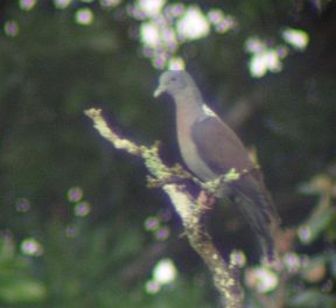Bronze-naped Pigeon

Original source: Alan Manson
Author: Alan Manson
The Bronze-naped Pigeon is classified as Least Concern. Does not qualify for a more at risk category. Widespread and abundant taxa are included in this category.
English: Bronze-naped Pigeon, Gabon Bronze-naped Pigeon, Western Bronze naped Pigeon, Western Bronze-naped Pigeon Spanish: Paloma de Nuca Bronceada, Paloma Nuquibronceada Estonian: pronkskael-tuvi Finnish: Pronssiniskakyyhky French: Pigeon à nuque bronzée Italian: Colomba nuca bronzata, Piccione nucabronzo occidentale Japanese: kobashibato, nijeribato Japanese: コバシバト, ニジェリバト Latin: Columba iriditorques, Columba iriditorques rothschildi Dutch: Bronsnekduif Norwegian: Bronsenakkedue Polish: golab lsniacy, Gołąb lśniacy, gołąb lśniący Slovak: holub bronzovošijí More
The Eastern Bronze-naped Pigeon (Columba delegorguei) is a species of bird in the Columbidae family. It is found in Angola, Kenya, Malawi, Mozambique, South Africa, Sudan, Tanzania, Uganda, Zambia, and Zimbabwe. It is part of the Turturoena subgenus. References - * BirdLife International 2004. Columba delegorguei. 2006 IUCN Red List of Threatened Species. Downloaded on 24 July 2007. Stub icon This Columbiformes-related article is a stub. More
The Western Bronze-naped Pigeon (Columba iriditorques) is a species of bird in the Columbidae family. It is found in Angola, Benin, Cameroon, Central African Republic, Republic of the Congo, Democratic Republic of the Congo, Ivory Coast, Equatorial Guinea, Gabon, Ghana, Guinea, Liberia, Nigeria, Sierra Leone, Sudan, Togo, Uganda, and Zambia. It is part of the Turturoena subgenus. References - * BirdLife International 2004. Columba iriditorques. More
* Eastern Bronze-naped Pigeon/Sam Woods Male perched on treetops. Dlinza Forest Nature Reserve, KwaZulu Natal Province, South Africa (ssp delegorguei) Sam Woods 12 October 2009 21 weeks ago 2 Sounds 1 recording * Calling in the treetops. Recorded from the canopy walkway. More
Distribution of Eastern bronze-naped pigeon in southern Africa, based on statistical smoothing of the records from first SA Bird Atlas Project (© Animal Demography unit, University of Cape Town; smoothing by Birgit Erni and Francesca Little). Colours range from dark blue (most common) through to yellow (least common). See here for the latest distribution from the SABAP2. Contact us if you can contribute information or images to improve this page. More
Family : Columbidae
Genus : Columba
Species : delegorguei
Authority : Delegorgue, 1847
